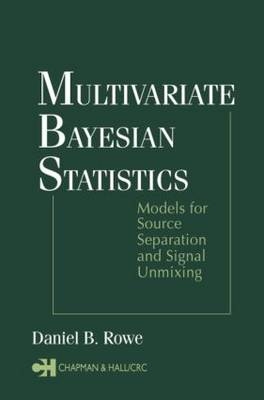
Multivariate Bayesian Statistics
Models for Source Separation and Signal Unmixing
Seiten
2002
Chapman & Hall/CRC (Verlag)
978-1-58488-318-0 (ISBN)
Chapman & Hall/CRC (Verlag)
978-1-58488-318-0 (ISBN)
- Titel z.Zt. nicht lieferbar
- Versandkostenfrei
- Auch auf Rechnung
- Artikel merken
Real-world source separation problems, encountered in disciplines from engineering and computer science to economics and image processing, are more difficult than they appear. Multivariate Bayesian Statistics: Models for Source Separation and Signal Unmixing offers a thorough, self-contained treatment of the source separation problem. Part I provid
Of the two primary approaches to the classic source separation problem, only one does not impose potentially unreasonable model and likelihood constraints: the Bayesian statistical approach. Bayesian methods incorporate the available information regarding the model parameters and not only allow estimation of the sources and mixing coefficients, but also allow inferences to be drawn from them.
Multivariate Bayesian Statistics: Models for Source Separation and Signal Unmixing offers a thorough, self-contained treatment of the source separation problem. After an introduction to the problem using the "cocktail-party" analogy, Part I provides the statistical background needed for the Bayesian source separation model. Part II considers the instantaneous constant mixing models, where the observed vectors and unobserved sources are independent over time but allowed to be dependent within each vector. Part III details more general models in which sources can be delayed, mixing coefficients can change over time, and observation and source vectors can be correlated over time. For each model discussed, the author gives two distinct ways to estimate the parameters.
Real-world source separation problems, encountered in disciplines from engineering and computer science to economics and image processing, are more difficult than they appear. This book furnishes the fundamental statistical material and up-to-date research results that enable readers to understand and apply Bayesian methods to help solve the many "cocktail party" problems they may confront in practice.
Of the two primary approaches to the classic source separation problem, only one does not impose potentially unreasonable model and likelihood constraints: the Bayesian statistical approach. Bayesian methods incorporate the available information regarding the model parameters and not only allow estimation of the sources and mixing coefficients, but also allow inferences to be drawn from them.
Multivariate Bayesian Statistics: Models for Source Separation and Signal Unmixing offers a thorough, self-contained treatment of the source separation problem. After an introduction to the problem using the "cocktail-party" analogy, Part I provides the statistical background needed for the Bayesian source separation model. Part II considers the instantaneous constant mixing models, where the observed vectors and unobserved sources are independent over time but allowed to be dependent within each vector. Part III details more general models in which sources can be delayed, mixing coefficients can change over time, and observation and source vectors can be correlated over time. For each model discussed, the author gives two distinct ways to estimate the parameters.
Real-world source separation problems, encountered in disciplines from engineering and computer science to economics and image processing, are more difficult than they appear. This book furnishes the fundamental statistical material and up-to-date research results that enable readers to understand and apply Bayesian methods to help solve the many "cocktail party" problems they may confront in practice.
Daniel B. Rowe holds a joint appointment as an assistant professor of Biophysics and Biostatistics at the Medical College of Wisconsin, Milwaukee, Wisconsin, USA.
FUNDAMENTALS: Statistical Distributions. Introductory Bayesian Statistics. Prior Distribution. Hyperparameter Assessment. Bayesian Estimation Methods. MODELS: Introduction. Bayesian Regression. Bayesian Factor Analysis. Bayesian Source Separation. Unobservable and Observable Sources. fMRI Case Study. GENERALIZATIONS: Delayed sources and Dynamic Coefficients. Correlated Observation and Source Vectors. fMRI Case Study. APPENDICES: Activation Determination. fMRI Hyperparameter Assessment.
| Erscheint lt. Verlag | 25.11.2002 |
|---|---|
| Zusatzinfo | 46 Tables, black and white; 19 Illustrations, black and white |
| Sprache | englisch |
| Maße | 156 x 234 mm |
| Gewicht | 666 g |
| Themenwelt | Mathematik / Informatik ► Mathematik ► Statistik |
| ISBN-10 | 1-58488-318-9 / 1584883189 |
| ISBN-13 | 978-1-58488-318-0 / 9781584883180 |
| Zustand | Neuware |
| Informationen gemäß Produktsicherheitsverordnung (GPSR) | |
| Haben Sie eine Frage zum Produkt? |
Mehr entdecken
aus dem Bereich
aus dem Bereich
Eine Einführung für Wirtschafts- und Sozialwissenschaftler
Buch | Softcover (2022)
De Gruyter Oldenbourg (Verlag)
CHF 41,90


